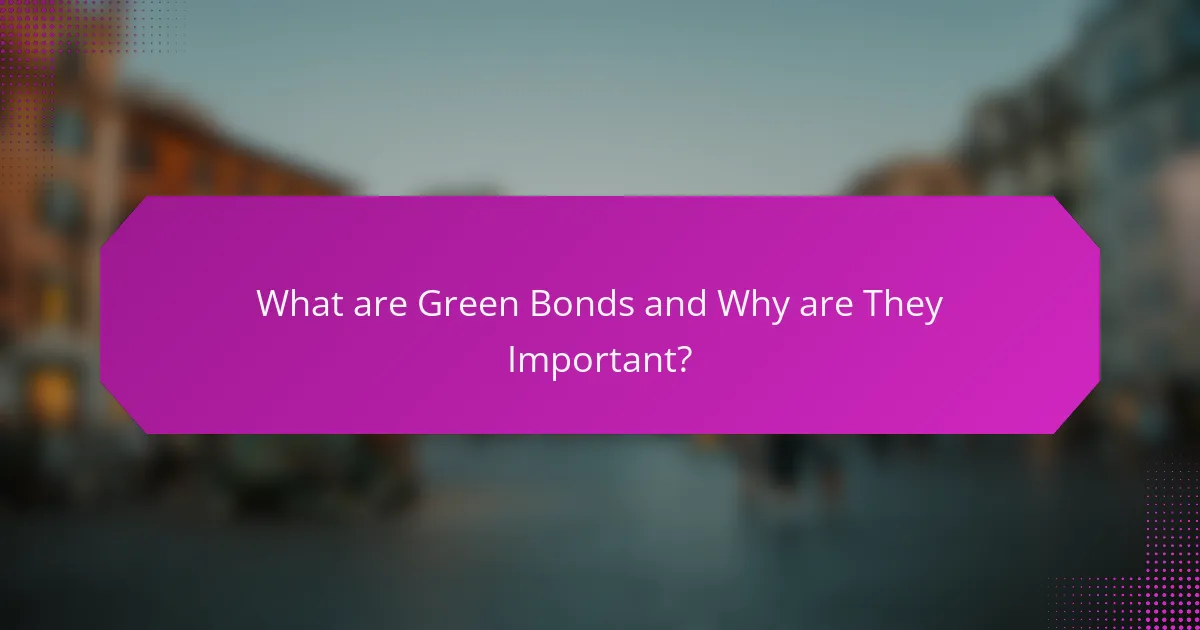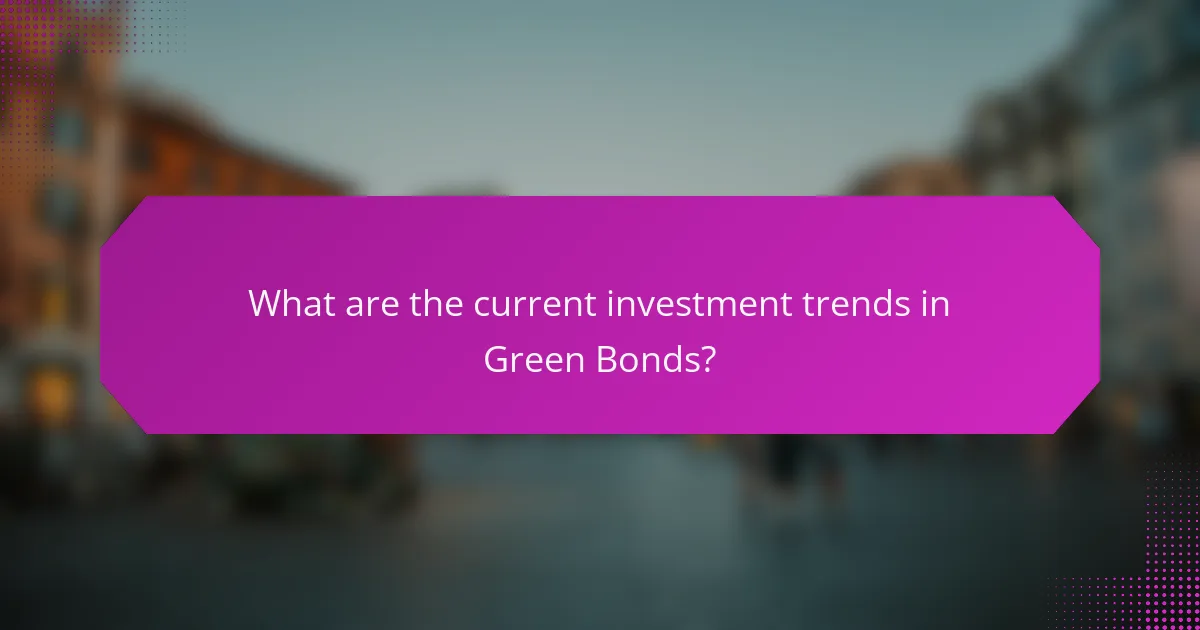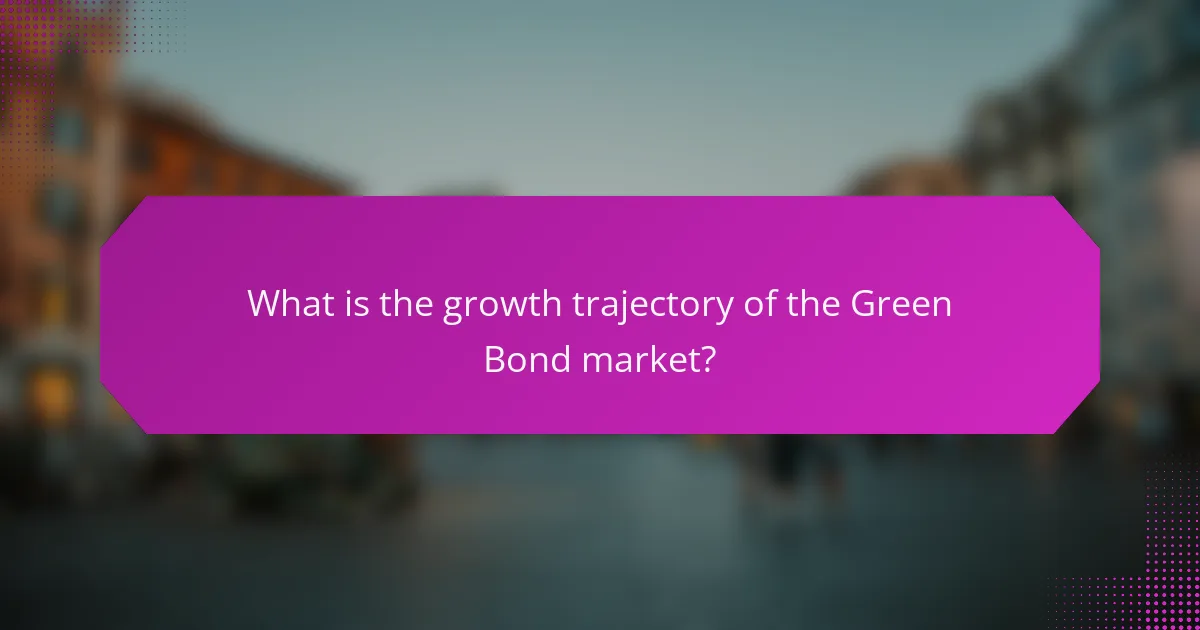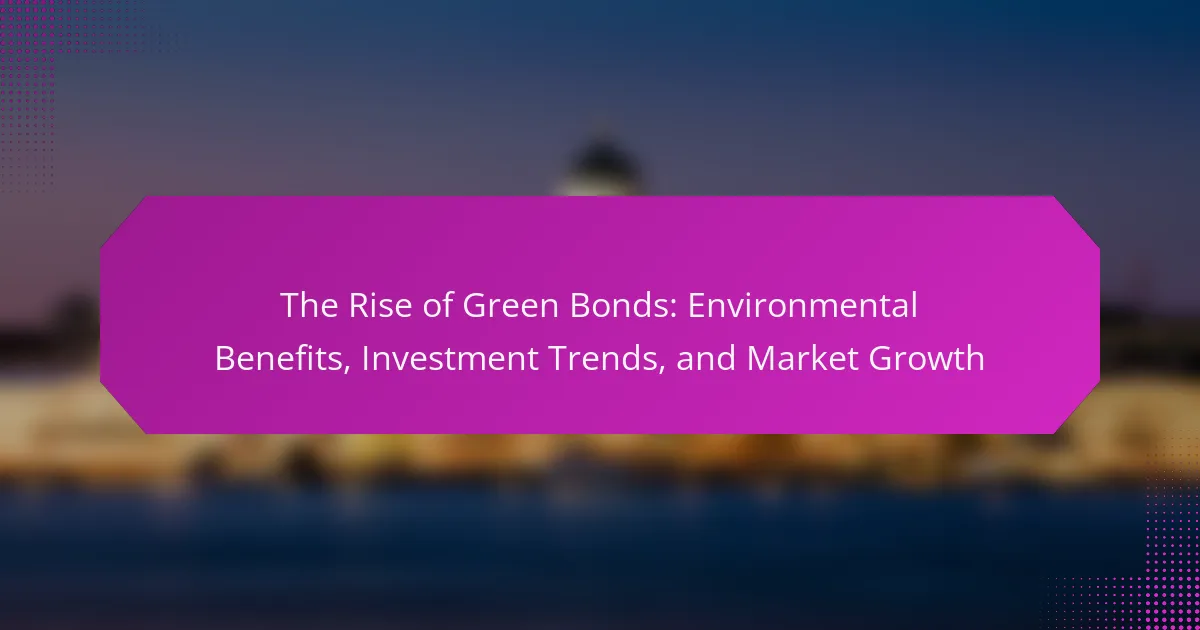Green bonds are fixed-income financial instruments aimed at funding projects that yield positive environmental impacts, such as renewable energy and sustainable infrastructure. The global green bond market has experienced significant growth, reaching approximately $500 billion in issuance in 2023, a 25% increase from the previous year. This growth is driven by increasing demand from institutional investors and the integration of Environmental, Social, and Governance (ESG) criteria into investment strategies. Governments and corporations are actively issuing green bonds to support climate change mitigation efforts, with a focus on transparency and effective allocation of funds. The market’s expansion is further supported by regulatory frameworks and government incentives, indicating a robust future for green bonds as a vital component of sustainable finance.

What are Green Bonds and Why are They Important?
Green bonds are fixed-income financial instruments specifically designed to fund projects that have positive environmental impacts. They are important because they mobilize capital for sustainable development initiatives. The global green bond market reached $1 trillion in issuance by 2021. This growth reflects the increasing demand for environmentally responsible investment options. Green bonds help finance renewable energy, energy efficiency, and sustainable infrastructure projects. Investors are attracted to green bonds due to their potential for both financial return and positive environmental impact. Additionally, they contribute to climate change mitigation efforts, aligning with global sustainability goals.
How do Green Bonds differ from traditional bonds?
Green bonds differ from traditional bonds primarily in their use of proceeds. Green bonds specifically fund projects with environmental benefits, such as renewable energy or energy efficiency. In contrast, traditional bonds can finance a wide range of projects without environmental considerations. The market for green bonds has grown significantly, reaching over $1 trillion in issuance by 2021. This growth reflects increasing investor demand for sustainable investment options. Furthermore, green bonds often require transparency and accountability in how funds are used, typically involving third-party verification. Traditional bonds do not have such stringent requirements. The focus on sustainability makes green bonds attractive to socially responsible investors.
What specific projects do Green Bonds typically fund?
Green Bonds typically fund projects that have positive environmental impacts. These projects include renewable energy installations, such as solar and wind farms. They also finance energy efficiency improvements in buildings and infrastructure. Water management projects, including sustainable water supply and wastewater treatment, are commonly funded. Additionally, Green Bonds support sustainable agriculture initiatives and reforestation efforts. According to the Climate Bonds Initiative, over $1 trillion has been issued in Green Bonds, underscoring their role in financing these critical projects.
Why is the classification of a bond as ‘green’ significant?
The classification of a bond as ‘green’ is significant because it indicates that the bond’s proceeds are used exclusively for environmentally beneficial projects. Green bonds are designed to finance projects that contribute to sustainability, such as renewable energy, energy efficiency, and clean transportation. This classification attracts investors who prioritize environmental responsibility in their portfolios. According to the Climate Bonds Initiative, the green bond market reached $1 trillion in issuance in 2020, reflecting growing investor interest. Furthermore, green bonds often offer favorable financing conditions due to increased demand from socially responsible investors. This classification also enhances transparency and accountability in funding environmentally friendly initiatives.
What are the environmental benefits of Green Bonds?
Green bonds provide significant environmental benefits by financing projects that address climate change and promote sustainability. They fund renewable energy initiatives, such as solar and wind power, which reduce greenhouse gas emissions. Green bonds also support energy efficiency upgrades in buildings, leading to lower energy consumption. Additionally, they finance sustainable water management projects, improving water quality and conservation. According to the Climate Bonds Initiative, green bonds raised over $250 billion in 2019 alone, demonstrating their growing impact. These funds contribute to the transition towards a low-carbon economy and help mitigate the effects of climate change.
How do Green Bonds contribute to sustainable development?
Green Bonds contribute to sustainable development by financing environmentally friendly projects. They support initiatives such as renewable energy, energy efficiency, and sustainable agriculture. According to the Climate Bonds Initiative, the global green bond market reached $1 trillion in issuance by 2020. This significant investment enables large-scale projects that reduce carbon emissions. Green Bonds also promote transparency and accountability in the use of funds. They require issuers to report on the environmental impact of financed projects. This accountability fosters trust among investors and stakeholders. Ultimately, Green Bonds play a crucial role in mobilizing capital for a sustainable future.
What measurable impacts do Green Bonds have on carbon emissions?
Green Bonds have a measurable impact on reducing carbon emissions. They finance projects aimed at environmental sustainability, such as renewable energy and energy efficiency. According to the Climate Bonds Initiative, projects funded by Green Bonds have the potential to reduce global carbon emissions by an estimated 1.5 gigatons annually. This reduction can be verified through emissions assessments of specific projects. For instance, a solar energy project financed by Green Bonds can offset approximately 1,200 tons of CO2 emissions per year. Overall, Green Bonds contribute significantly to climate change mitigation efforts through targeted funding.

What are the current investment trends in Green Bonds?
Current investment trends in green bonds show significant growth and diversification. In 2023, global green bond issuance reached approximately $500 billion. This marks a 25% increase compared to the previous year. Institutional investors are increasingly favoring green bonds for their sustainable investment portfolios.
Governments and corporations are issuing more green bonds to finance renewable energy projects. The demand for transparency and accountability in green bond projects is rising. Investors seek assurance that funds are allocated effectively towards environmental initiatives. Additionally, the integration of ESG (Environmental, Social, and Governance) criteria is becoming standard in investment strategies.
The market is witnessing the emergence of innovative structures, such as green securitizations. These trends indicate a robust future for green bonds as a key component of sustainable finance.
Which sectors are seeing the most investment through Green Bonds?
The sectors seeing the most investment through Green Bonds include renewable energy, energy efficiency, sustainable waste management, and sustainable agriculture. Renewable energy projects, such as solar and wind farms, attract significant funding. Energy efficiency improvements in buildings also receive substantial investments. Sustainable waste management initiatives focus on recycling and waste-to-energy systems. Sustainable agriculture investments promote eco-friendly farming practices and technologies. In 2022, renewable energy projects accounted for over 60% of Green Bond issuances, highlighting the sector’s dominance. Energy efficiency projects followed closely, making up about 20% of total issuances.
How has investor interest in Green Bonds evolved over time?
Investor interest in Green Bonds has significantly increased over the past decade. Initially, the market was small, with only $3 billion issued in 2012. By 2020, issuance surged to over $250 billion globally. This growth reflects a rising demand for sustainable investment options. Institutional investors, such as pension funds and insurance companies, have been key drivers. They seek to align portfolios with environmental, social, and governance (ESG) criteria. The COVID-19 pandemic further accelerated interest in sustainable finance. According to the Climate Bonds Initiative, Green Bonds are projected to reach $1 trillion in issuance by 2023. This indicates a robust and growing market for environmentally-focused investments.
What role do institutional investors play in the Green Bond market?
Institutional investors play a crucial role in the Green Bond market by providing significant capital for environmentally sustainable projects. They include entities such as pension funds, insurance companies, and mutual funds. These investors seek to align their portfolios with sustainable investment goals. In 2020, institutional investors accounted for approximately 60% of the total Green Bond issuance. Their participation helps to enhance the credibility and visibility of the Green Bond market. Institutional investors often conduct rigorous assessments of the environmental impact of projects. This due diligence ensures that funds are allocated to genuinely sustainable initiatives. Their involvement also drives demand, leading to increased issuance of Green Bonds. Overall, institutional investors are vital for the growth and stability of the Green Bond market.
What challenges are faced by investors in the Green Bond market?
Investors in the Green Bond market face several challenges. One significant challenge is the lack of standardization in what qualifies as a green project. This inconsistency can lead to confusion and misallocation of funds. Another challenge is the limited number of investment options available. The market is still developing, which restricts diversification. Additionally, investors may encounter transparency issues regarding the use of proceeds from green bonds. Without clear reporting, it’s difficult to assess environmental impacts. Market liquidity is also a concern, as green bonds can be less liquid than traditional bonds. Finally, there are regulatory risks that can affect the market’s stability. These challenges can hinder investor confidence and participation in the Green Bond market.
How do regulatory frameworks impact Green Bond investments?
Regulatory frameworks significantly influence Green Bond investments by providing guidelines and standards for issuers. These frameworks ensure transparency and accountability in the use of proceeds. Clear regulations help to build investor confidence in the integrity of Green Bonds. For instance, the European Union’s Green Bond Standard establishes criteria for what constitutes a green project. This standardization aids in the comparability of investments. Furthermore, regulatory incentives, such as tax breaks or subsidies, can enhance the attractiveness of Green Bonds. According to the Climate Bonds Initiative, robust regulations can lead to increased market growth and participation. Overall, effective regulatory frameworks are essential for fostering a trustworthy environment for Green Bond investments.
What risks are associated with investing in Green Bonds?
Investing in Green Bonds carries several risks. One significant risk is credit risk, which refers to the possibility that the issuer may default on interest payments or principal repayment. This risk can vary depending on the financial stability of the issuing entity, such as corporations or governments.
Market risk is another concern, as the value of Green Bonds can fluctuate based on market conditions, interest rates, and investor sentiment. Environmental risk also exists, where projects funded by Green Bonds may not achieve their intended environmental benefits, potentially impacting the bond’s value.
Liquidity risk is present as well, meaning that investors may find it difficult to sell their Green Bonds quickly without affecting the price. Regulatory risk is also a factor, as changes in government policies regarding green initiatives could impact the attractiveness of Green Bonds.
Lastly, there is the risk of greenwashing, where issuers may overstate the environmental benefits of their projects, leading to potential reputational damage for investors. These risks highlight the importance of thorough research and due diligence before investing in Green Bonds.

What is the growth trajectory of the Green Bond market?
The growth trajectory of the Green Bond market has been significant and rapid. The market reached a record issuance of approximately $500 billion in 2021. This represents a 90% increase from the previous year. The cumulative issuance since the market’s inception in 2007 has surpassed $1 trillion. The demand for sustainable investments is driving this growth. Institutional investors are increasingly allocating funds to green projects. Regulatory frameworks and government incentives are also supporting market expansion. According to the Climate Bonds Initiative, the market is projected to reach $1 trillion annually by 2023. This growth reflects a broader trend towards sustainable finance globally.
How has the market for Green Bonds expanded in recent years?
The market for Green Bonds has expanded significantly in recent years. In 2020, global issuance reached a record $269.5 billion, a 9% increase from 2019. This growth is driven by heightened investor awareness of climate change and sustainable finance. Institutional investors are increasingly allocating funds to green projects. The European Union’s Green Deal has also boosted market confidence. Additionally, more corporations are issuing Green Bonds to finance eco-friendly initiatives. The market is projected to exceed $1 trillion in annual issuance by 2023. This trend reflects a growing commitment to sustainability across various sectors.
What are the projections for future growth in the Green Bond sector?
The Green Bond sector is projected to grow significantly in the coming years. Analysts forecast that the market could reach $1 trillion in issuance by 2023. This growth is driven by increasing demand for sustainable investments. More investors are prioritizing environmental, social, and governance (ESG) criteria. In 2021, global green bond issuance reached a record $517 billion, reflecting strong market momentum. The International Finance Corporation estimates that $23 trillion is needed to meet climate goals by 2030. This indicates a substantial opportunity for green bonds to play a crucial role in financing sustainable projects.
What factors are driving the growth of the Green Bond market?
Increasing demand for sustainable investments is driving the growth of the Green Bond market. Investors are increasingly prioritizing environmental, social, and governance (ESG) criteria. Regulatory support from governments is enhancing market confidence. For instance, the European Union has implemented a Green Bond Standard to ensure transparency. Additionally, corporate commitments to carbon neutrality are fueling issuance. In 2021, global green bond issuance reached a record $500 billion. This trend reflects a growing awareness of climate change and the need for sustainable financing. Financial institutions are also developing green bond products to meet investor demand.
How do global climate policies influence Green Bond issuance?
Global climate policies significantly influence Green Bond issuance by establishing regulatory frameworks and incentives. These policies create a conducive environment for investment in sustainable projects. For instance, the Paris Agreement encourages countries to commit to emissions reduction targets. This commitment drives demand for financing mechanisms like Green Bonds.
In 2020, global Green Bond issuance reached a record $269.5 billion, partly due to heightened climate action commitments. Policymakers often provide tax incentives or subsidies for projects funded through Green Bonds. Additionally, regulations requiring corporate transparency on environmental impact boost investor confidence in Green Bonds.
As countries adopt stricter climate targets, the market for Green Bonds is likely to expand further. The alignment of Green Bond projects with national climate goals enhances their attractiveness to investors. Thus, global climate policies play a crucial role in shaping the Green Bond market by fostering a supportive investment landscape.
What trends are emerging in Green Bond issuance and demand?
Emerging trends in Green Bond issuance include increased market participation and diversification of issuers. In 2023, global Green Bond issuance reached approximately $500 billion, a significant increase from previous years. Demand for Green Bonds is driven by growing investor interest in sustainable finance. Institutional investors are increasingly prioritizing Environmental, Social, and Governance (ESG) criteria in their portfolios. Additionally, there is a rise in corporate issuers entering the Green Bond market. This trend reflects a broader commitment to sustainability and climate action. Geographic diversification is also notable, with emerging markets becoming more active in Green Bond issuance. These trends indicate a robust growth trajectory for the Green Bond market, aligning financial investments with environmental goals.
What best practices should investors consider when investing in Green Bonds?
Investors should consider several best practices when investing in Green Bonds. Firstly, they should verify the credibility of the issuer. This includes checking if the issuer has a strong track record in sustainability. Investors should also review the use of proceeds. It is essential to ensure that funds are allocated to environmentally beneficial projects.
Moreover, understanding the bond’s certification is crucial. Many Green Bonds are certified by third-party organizations, which adds credibility. Investors should also assess the bond’s performance metrics. This includes evaluating both financial returns and environmental impact.
Additionally, diversification is a key strategy. Investing in a variety of Green Bonds can mitigate risk. Finally, staying informed about market trends is important. The Green Bond market is evolving, and awareness can enhance investment decisions.
Green bonds are fixed-income financial instruments designed to fund projects with positive environmental impacts, playing a crucial role in mobilizing capital for sustainable development. The article explores the significance of green bonds, their differences from traditional bonds, and the specific projects they finance, such as renewable energy and energy efficiency initiatives. It highlights current investment trends, the sectors attracting the most funding, and the evolving role of institutional investors, while also addressing challenges and risks associated with investing in green bonds. Additionally, the article examines the growth trajectory of the green bond market and the influence of global climate policies on issuance and demand.
